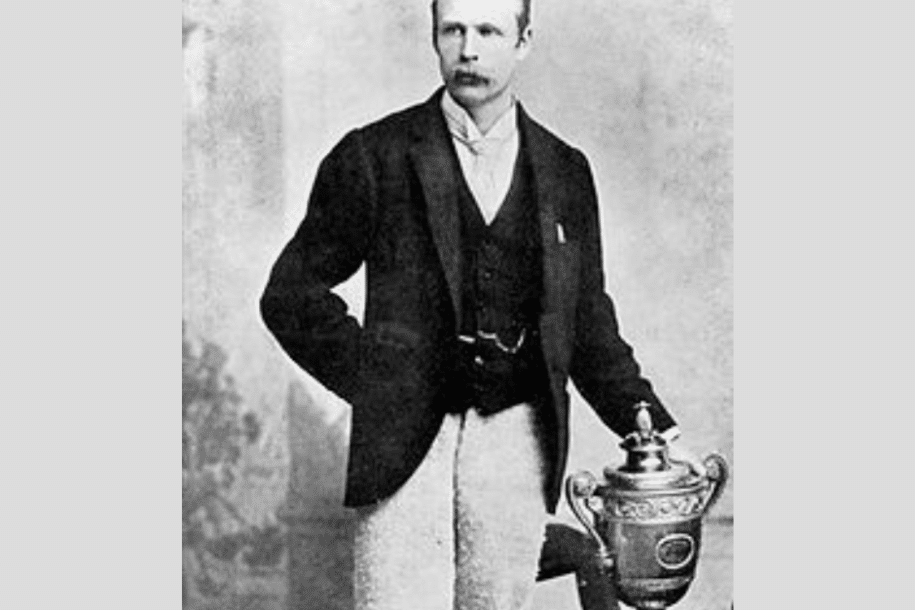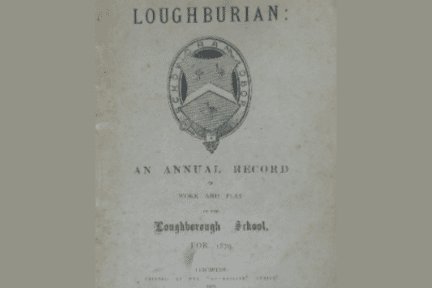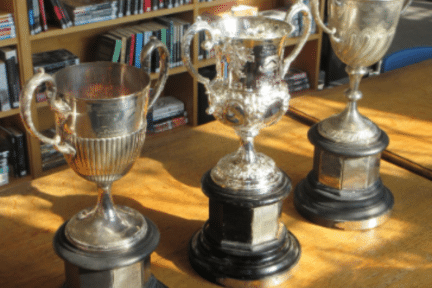T is for Tennis

The tennis report in the very first Loughburian of 1879 ends with these words ‘The result of this year’s contest for the Captaincy is that Hamilton is victorious. Paget was absent and did not compete, or the result might have been different; but in Hamilton we have one who is likely to develop into a thoroughly good athlete – especially in Cricket.’ 11 years later, aged just 25, Hamilton becomes the first (of three) Irishman to win Wimbledon.
(James) Willoughby Hamilton was born on 9 December 1864 in Monasterevin, County Kildare, the seventh of nine children of Revd. Canon William Alfred Hamilton, a Church of Ireland rector, and Henrietta Cole. So the obvious question is – why did they chose LGS as the boarding School for their very sporty son? Surely a more prestigious boarding school would have been their choice. Here the clue comes from the knowledge that his big brother – 15 years older – is Revd Henry Balfour Hamilton who we know became the first Rector of the recently restored St Helena’s Church in West Leake in 1882, the year after Willoughby left LGS. So it is likely that he was at another local church prior to that appointment and able to look after little brother at half-terms etc.
Willoughby entered LGS in 1876 and would have been a boarder in School House under Headmaster John Colgrove. The following extract from an 1886 edition of Pastime provides an insight into his time here. ‘His schooldays were spent at Loughborough Grammar School, Leicestershire, where he made his mark in outdoor games and exercise, winning several races each year in the athletic sports, besides gaining a place in the cricket and football teams. During his last year he was captain of both the elevens, and won the bat given as prize for the highest cricket averages. At lawn tennis, for three years, he held the position of champion of the school.’
We know from the report of the School v Old Boys Cricket match in the Loughburian of 1881, Willoughby’s last year in the School, that he takes three wickets and top scores with 46 (being run out!) in a crushing victory for the School. We also know from the Loughburian that the one thing he wasn’t was academic! Although 17 we find him in the Fourth Form (The third tier in a School that numbered 120 at the time) and there he is 19th out of 21 and scored just two in his Algebra!
Pastime takes up his story ‘Leaving school before the completion of his seventeenth year, Hamilton entered a stockbroker’s office in Dublin, in which city he has since remained. During the winter of 1884-5, he played Association football with such success as to be included in the Leinster team against Ulster, and to gain his international cap in the annual engagement with Wales. As a right wing forward he had, at that time, few, if any, equals in the country. Finding that he could not spare time to play cricket to his own satisfaction, although he had acquired a high reputation as a splendid field and a very promising batsman, he determined to abandon the game in favour of lawn tennis. From this point his improvement was rapid and consistent…’
After considerable success in Ireland, especially against his big brother William who was five years older than him and also represented Ireland at Soccer and Cricket (indeed it was a very sporty family as brothers Francis and Blayney also represented Ireland at Cricket!), he entered Wimbledon for the first time in 1896 and reached the quarter finals. In 1887, the County Dublin Championships clashed with the tournament but when he returned in 1888 he reached the semi-finals, which he also reached again in 1889.
In 1890, he went two stages further. He won the All-Comers competition and qualified to meet William Renshaw, the six times previous winner, for the Championship. The following description of the match is from the Daily News. ‘Some very even play was seen in the first set which was secured by Renshaw by 8 to 6. In the second set Hamilton obtained an easy victory by 6 to 2, whilst the third set went to the holder at 6-3. After this Renshaw did not meet with much success, and Hamilton taking the fourth and fifth sets at 6-1 each, won the Championship by 3 sets to 2. Of the 45 games played. Hamilton won 27.’ This, along with his other tournament successes, meant that he was ranked Number 1 in the world.


What happened next is one of the great mysteries in sport. He never ever competed in another competitive tennis match and no-one seems to know why. According to more than one source a serious illness, blood poisoning, was said to be the cause but it is unlikely that he was seriously ill for too long as he married five years later and was working as a stockbroker in 1911. Indeed – there is evidence that he continued playing football and cricket – was he just fed up playing tennis? He lived for 53 years after his Wimbledon triumph until he died on 27th September 1943 in Dundrum, Dublin, aged 78.
As you might expect his triumph at Wimbledon was at the centre of the Chairman of Governors speech at prize giving. Mr Hussey Packe mentioned the excitement of the boys over Hamilton’s success at Wimbledon and their efforts to establish three silver challenge cups for cricket, football and tennis. Thus Hamilton’s success established the House System, which after many changes, is still in place to this day. The Loughburian of January 1891 reports that there are to be four houses:- School House; Burton House, the other boarding house; and the Day Boys, who were split in two – North & South – by residence. It also records ‘There have been several committee meetings about the Challenge Cups: after much deliberation, the inscriptions and the cups themselves have all been determined on, Ingenious members of the committee even made the designs after their own heart in which figured a pair of legs in deadly collision over a ball and various other devices.’
They were competed for that year and the next edition of The Loughburian in December 1891 records ‘Since the last issue of this magazine the Challenge Cups have come into our possession, and they are well worthy of the ancient institution to which they belong. Their total cost amounted to £66, a sum which has practically been raised by present boys and the School’s alumni; a few subscriptions were also received from others who were interested in the movement. The following are the names of the Captains and Teams who won the cups this year:-
Football South – Day Boys Paget i
Cricket School House Stephenson
Tennis North – Day Boys Toone’
The Cups were funded by the boys (parents!) of the new ‘Houses’. The Football Cup by the Day Boys with 39 listed donors; the Cricket Cup by Burton House with 26 donors and the Hamilton Cup by School House with 19 donors including the Headmaster.
Indeed, he was so taken by Hamilton’s triumph that ‘During the Midsummer holidays our Head Master has very generously had the old ash court asphalted at his own expense, and we feel sure that the whole school will heartily join us in thanking him for his great munificence.’ In those days the tennis court was on the quad.
Thus these are the three oldest and most important cups we own…and I mean own. For just three years later, after Colgrove was dismissed as Headmaster, he set up a rival School taking all three cups with him! On 8 February 1898 the Governors asked him to return the Hamilton Cup, which he refused to do, and sent him a bill for £8 which you will gather was below what the cup was worth! His rival School closed two years later and the cups were returned and as a consequence have inscribed on the base, This Cup is the property of the masters and boys, after all they had paid for it!
All three trophies are still awarded to this day.
